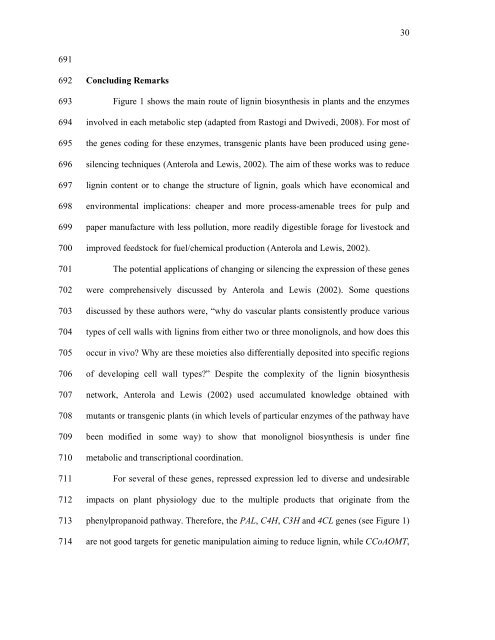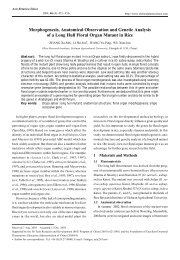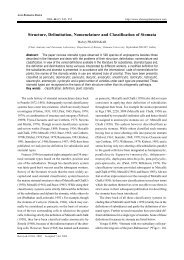Abiotic and biotic stresses and changes in the lignin ... - ResearchGate
Abiotic and biotic stresses and changes in the lignin ... - ResearchGate
Abiotic and biotic stresses and changes in the lignin ... - ResearchGate
Create successful ePaper yourself
Turn your PDF publications into a flip-book with our unique Google optimized e-Paper software.
30<br />
691<br />
692<br />
693<br />
694<br />
695<br />
696<br />
697<br />
698<br />
699<br />
700<br />
701<br />
702<br />
703<br />
704<br />
705<br />
706<br />
707<br />
708<br />
709<br />
710<br />
711<br />
712<br />
713<br />
714<br />
Conclud<strong>in</strong>g Remarks<br />
Figure 1 shows <strong>the</strong> ma<strong>in</strong> route of lign<strong>in</strong> biosyn<strong>the</strong>sis <strong>in</strong> plants <strong>and</strong> <strong>the</strong> enzymes<br />
<strong>in</strong>volved <strong>in</strong> each metabolic step (adapted from Rastogi <strong>and</strong> Dwivedi, 2008). For most of<br />
<strong>the</strong> genes cod<strong>in</strong>g for <strong>the</strong>se enzymes, transgenic plants have been produced us<strong>in</strong>g genesilenc<strong>in</strong>g<br />
techniques (Anterola <strong>and</strong> Lewis, 2002). The aim of <strong>the</strong>se works was to reduce<br />
lign<strong>in</strong> content or to change <strong>the</strong> structure of lign<strong>in</strong>, goals which have economical <strong>and</strong><br />
environmental implications: cheaper <strong>and</strong> more process-amenable trees for pulp <strong>and</strong><br />
paper manufacture with less pollution, more readily digestible forage for livestock <strong>and</strong><br />
improved feedstock for fuel/chemical production (Anterola <strong>and</strong> Lewis, 2002).<br />
The potential applications of chang<strong>in</strong>g or silenc<strong>in</strong>g <strong>the</strong> expression of <strong>the</strong>se genes<br />
were comprehensively discussed by Anterola <strong>and</strong> Lewis (2002). Some questions<br />
discussed by <strong>the</strong>se authors were, “why do vascular plants consistently produce various<br />
types of cell walls with lign<strong>in</strong>s from ei<strong>the</strong>r two or three monolignols, <strong>and</strong> how does this<br />
occur <strong>in</strong> vivo? Why are <strong>the</strong>se moieties also differentially deposited <strong>in</strong>to specific regions<br />
of develop<strong>in</strong>g cell wall types?” Despite <strong>the</strong> complexity of <strong>the</strong> lign<strong>in</strong> biosyn<strong>the</strong>sis<br />
network, Anterola <strong>and</strong> Lewis (2002) used accumulated knowledge obta<strong>in</strong>ed with<br />
mutants or transgenic plants (<strong>in</strong> which levels of particular enzymes of <strong>the</strong> pathway have<br />
been modified <strong>in</strong> some way) to show that monolignol biosyn<strong>the</strong>sis is under f<strong>in</strong>e<br />
metabolic <strong>and</strong> transcriptional coord<strong>in</strong>ation.<br />
For several of <strong>the</strong>se genes, repressed expression led to diverse <strong>and</strong> undesirable<br />
impacts on plant physiology due to <strong>the</strong> multiple products that orig<strong>in</strong>ate from <strong>the</strong><br />
phenylpropanoid pathway. Therefore, <strong>the</strong> PAL, C4H, C3H <strong>and</strong> 4CL genes (see Figure 1)<br />
are not good targets for genetic manipulation aim<strong>in</strong>g to reduce lign<strong>in</strong>, while CCoAOMT,







